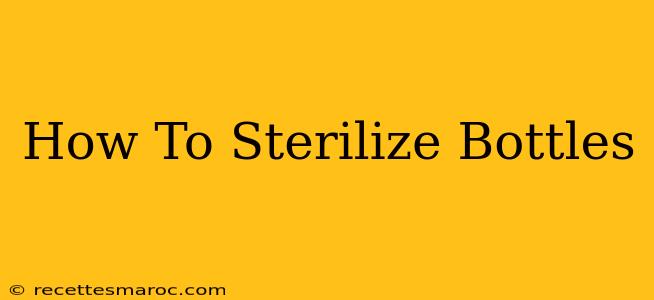Congratulations on your little one! As any new parent knows, keeping your baby healthy is paramount. A crucial part of that is ensuring that all feeding equipment, especially baby bottles, are thoroughly sterilized. This guide will walk you through various methods for sterilizing bottles, helping you choose the best option for your family and lifestyle.
Why Sterilize Baby Bottles?
Before we dive into the how, let's understand the why. A baby's immune system is still developing, making them vulnerable to infections. Bacteria, viruses, and other germs can easily contaminate bottles if not properly cleaned and sterilized. Sterilizing removes these harmful microorganisms, significantly reducing the risk of your baby developing illnesses like diarrhea, vomiting, or ear infections. Sterilizing bottles is essential for the first six months of your baby's life, but even beyond that, maintaining hygiene is key for their health.
Methods for Sterilizing Baby Bottles
There are several ways to sterilize baby bottles, each with its own pros and cons:
1. Boiling: The Classic and Reliable Method
This is a tried-and-true method that's both effective and accessible.
-
How to do it: Submerge the disassembled bottles (separating nipples, rings, and bottles) in a pot of boiling water for at least 5 minutes. Ensure all parts are fully submerged. Use tongs to remove them and let them air dry on a clean surface.
-
Pros: Simple, inexpensive, and requires no special equipment.
-
Cons: Can be time-consuming, and repeated boiling can damage some bottle materials over time. Also requires careful handling to avoid burns.
2. Steam Sterilizer: Fast and Convenient
Steam sterilizers use steam to kill germs, offering a faster and more convenient option than boiling.
-
How to do it: Place the disassembled bottles inside the sterilizer, add water as per the manufacturer's instructions, and turn it on. The steaming process usually takes around 5-10 minutes.
-
Pros: Quick, convenient, and effective. Many sterilizers come with storage capabilities, keeping bottles sterile until needed.
-
Cons: Requires purchasing a dedicated sterilizer, adding to the initial cost.
3. Cold Water Sterilization Tablets: On-the-Go Solution
These tablets dissolve in cold water, creating a sterilizing solution.
-
How to do it: Follow the manufacturer's instructions carefully. This usually involves dissolving a tablet in water, submerging the bottles, and letting them soak for the specified time.
-
Pros: Portable and convenient for travel or when boiling isn't an option.
-
Cons: Can be more expensive than boiling or using a steam sterilizer. The effectiveness depends on proper dilution and soaking time.
4. Microwave Sterilizer: Quick and Easy Microwave Sterilization
These sterilizers use microwave energy to produce steam, sterilizing bottles quickly.
-
How to do it: Place the disassembled bottles in the sterilizer, add water according to instructions and microwave for the specified time.
-
Pros: Fast and convenient, ideal for quick sterilization.
-
Cons: Requires a microwave oven. Not all types of bottles are suitable for this method. Check your bottles are microwave-safe before using this method.
Choosing the Right Method for You
The best sterilization method for you will depend on your budget, lifestyle, and available resources. Consider the pros and cons of each method before making your decision. For example, boiling is a great budget-friendly option, while steam sterilizers offer convenience. Cold water sterilization tablets are excellent for travel. Microwave Sterilizers provide a fast and effective way to sterilize baby bottles but be sure to choose a model that is compatible with your type of bottle.
Maintaining Hygiene Beyond Sterilization
Sterilization is a key step, but remember that maintaining overall hygiene is crucial. Always wash bottles thoroughly with hot, soapy water before sterilizing. Store sterilized bottles in a clean, dry place, preferably in a closed container or the sterilizer itself if it offers storage functionality. Regularly replace your bottles and nipples to maintain hygiene and prevent wear and tear.
By following these guidelines, you can ensure that your little one is fed from clean and safe bottles, contributing to their overall health and well-being. Remember to always consult your pediatrician for personalized advice.

